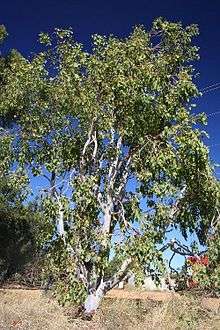Eucalyptus bigalerita
| Northern salmon gum | |
|---|---|
 | |
| Scientific classification | |
| Kingdom: | Plantae |
| Clade: | Angiosperms |
| Clade: | Eudicots |
| Clade: | Rosids |
| Order: | Myrtales |
| Family: | Myrtaceae |
| Genus: | Eucalyptus |
| Species: | E. bigalerita |
| Binomial name | |
| Eucalyptus bigalerita | |
| Synonyms | |
|
Eucalyptus pastoralis S.Moore | |
Eucalyptus bigalerita, commonly known as Northern salmon gum[1] or Adelaide River white gum,[2] is a species of Eucalyptus which is endemic to Australia.
Description
The tree typically grows to a height of 6 to 18 metres (20 to 59 ft).[3] The species has a single smooth trunk that varies from pale grey to coppery in colour.[3][2] It is oftendeciduous during the drier months prior to the wet season and forms a lignotuber.[4] The light green leaves have an ovoid to deltoid shape and are up to 15 centimetres (6 in) long and 10 cm (4 in) wide.[2] The leaves are alternate to sub-opposite with petioles that are 3.5 to 7 centimetres (1.4 to 2.8 in) long. The leaf base is broadly lobed to rounded to tapering to petiole with an entire margin and pointed apex.[4] It blooms in winter and spring between August and September producing yellow-white inflorescences[3] with a diameter of about 15 millimetres (0.59 in).[2] The inflorescence have of five to seven flowers on solitary and axillary umbels. The peduncles are stout, approximately 5 to 10 millimetres (0.20 to 0.39 in) long. The buds are sessile or shortly pedicellate with a globular to obovoid shape approximately 8 to 14 mm (0.31 to 0.55 in) in length and 7 to 11 mm (0.28 to 0.43 in) wide.[4]
The plant is easily propagated from seed which germinates readily.[2]
Distribution
Found along watercourses and low-lying flats in the Kimberley region of Western Australia where it grows in alluvium or sandy soils[3] and extending into the Northern Territory. It is found across the top end of the Northern Territory including the Tiwi Islands and Cobourg Peninsula and as far south as Daly Waters.[4]
Classification
It was first described by Ferdinand von Mueller in 1859[5] in the work Monograph of the Eucalypti of tropical Australia in the Journal of the Proceedings of the Linnean Society, Botany.[6] The only synonym is Eucalyptus pastoralis as described by Spencer Le Marchant Moore in 1902 in the Journal of Botany, British and Foreign.[6]
The name bigalerita is derived from the Latin words bi, meaning two and galeritus meaning wearing a skull-cap or hood, possibly referring to the shape of the operculum.[2]
E. bigalerita belongs to a small group of species closely related to the red gums. Other members include E. alba, E. platyphylla, E. tintinnans, E. apodophylla and E. houseana. Within the group E. bigalerita is most closely related to E. platyphylla and E. tintinnans and is only weakly separated from both.[4]
See also
References
- ↑ Philip A. Clarke (2012). Australian plants as Aboriginal Tools. Rosenberg Publishing. ISBN 9781922013576.
- 1 2 3 4 5 6 "Eucalyptus bigalerita". Australian Native Plants Society. January 2016. Retrieved 29 April 2017.
- 1 2 3 4 "Eucalyptus bigalerita". FloraBase. Western Australian Government Department of Parks and Wildlife.
- 1 2 3 4 5 "Eucalyptus bigalerita F.Muell. Myrtaceae". NT Flora. Northern Territory Government. Retrieved 29 April 2017.
- ↑ "Eucalyptus bigalerita F.Muell". Australian Plant Name Index (APNI), IBIS database. Centre for Plant Biodiversity Research, Australian Government.
- 1 2 "Eucalyptus bigalerita F.Muell. Northern Salmon Gum". Atlas of Living Australia. Global Biodiversity Information Facility. Retrieved 29 April 2017.